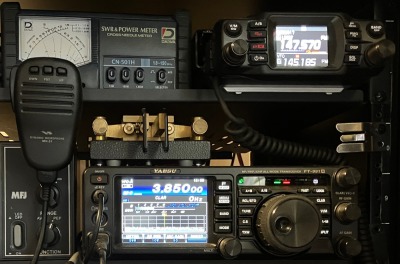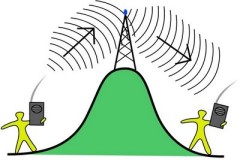Emergency Communications and Information
In an emergency, communication and timely information is a necessity. Communication devices can let you find out what is going on, and let others know if you require assistance. Phone lines and cell towers often go down or become overloaded in emergencies. These are a great primary resource, but not a good secondary/emergency resource.
Types of Communication and Distances
Most local radio communications use “Line of Sight”, meaning the antenna on one device must be able to “See” the other device’s antenna if you drew a straight line between them. This can include going through some non-reflecting structures (trees, some houses or buildings), but the more obstacles the signal encounters, the weaker it will get. In general, the higher your antenna, the farther you can communicate. Radio, TV, and Cellular networks use towers to raise their antennas higher for better coverage. Another Line of Sight limiting factor is the curvature of the Earth (horizon) since most signals cannot move through the ground or water. Some radio frequencies use Repeaters, which greatly extends the range and coverage area of radios by listening for your transmission on one frequency (input), and simultaneously retransmitting the signal back out (usually at a higher power) on another frequency. Since Repeater antennas are usually mounted high up on a tower and/or at the top of a hill, their line of sight is much better than handheld or mobile radios by themselves. AM broadcast radio, like in your car, uses ground waves during the day and can cover around 100 miles. At night, its signal can bounce off the Earth’s atmosphere (37 – 190 miles above Earth’s surface) and can go thousands of miles in the right conditions. This makes it very useful in emergencies since you could potentially hear stations outside of your affected area.
Types of Communication Devices
To see a list and comparison of some of the radios discussed here, check out our article called Handheld Transceiver (HT) Radio Comparisons for a link to some great radio charts and some links to some of the ones we recommend on Amazon.
CB or CBRS
Citizens Band Radio Service, most commonly called CB, has 40 standard channels, although more channels (USB/LSB/FM) are available on more expensive models. CB Is generally inexpensive, widely used, does not require a license, and is good for local communications. This is a type of AM radio, so the sound quality is not the greatest, but you can always find someone on the air.
FRS
The Field Radio Service (FRS) does not require a license. The radios for this service as fairly low power, and have a fixed antenna that cannot be changed or removed. The communication range is very limited (usually a 1/2 mile or so) although it all comes down to a clear line-of-sight. FRS radios are generally inexpensive, and readily available in most box stores on online.
GMRS
For GMRS there is a license requirement, but there is no test, and a $35 license fee covers your immediate family for 10 years. A coverage range of 1 – 2 miles handheld-to-handheld radio is typical, although you can stretch this by using a good antenna up as high as possible, or a higher powered radio like a mobile rig. GMRS is widely used, and it supports repeaters which can greatly extend your coverage are. GMRS is good for local communications. The FCC rules do not allow Repeaters to be linked, so you won’t get the same coverage area using repeaters as you would using Ham (amateur radio) repeaters in an emergency. GMRS radios use FM (Frequency Modulation), so the sound quality is much better than AM in general. For more information about GMRS, read our article on How to Get Your GMRS License.
Amateur (Ham) Radio
This type of radio requires you to pass a test to be licensed. Rules for its use must be followed. Depending on the band (frequency ranges) it can be used for local or worldwide coverage. It supports repeaters, which in an emergency will most likely be running and linked to one another to provide a very large area of coverage. The more expensive radios will have both AM and FM to use for different frequencies and purposes.For more information, read our article on How to Get Your Amateur Radio License.
AM/FM Broadcast Radio
AM/FM Broadcast is a one-way communication. It’s a good source of information for your local area, or at night on AM, a large area. It is listen-only, you will not be able to talk back. The information you get may not be as timely as needed in an emergency, but every vehicle made has to have a radio that can receive AM/FM.
Other
There are also special radios just for listening to the NOAA (National Oceanic and Atmospheric Administration) frequencies to give you 24/7 weather conditions and emergency alerts.
Prices for different communications devices
CB – Can be had for as little as $25 for a handheld, with mobile or base stations starting closer to $100 depending on device/antenna/output power.
FRS – Small handheld FRS radios start around $15 and go up depending on features. All FRS radios have the same low power settings.
GMRS – Handheld radios start around $25 and up. $100 – $200 can buy a VERY nice GMRS radio in either handheld or mobile.
Amateur Radio (Ham) – $35 and up for 2 meter/70cm handheld radios. Since most Amateur radios are targeted at a “radio-educated” crowd, they are generally built to higher standards and can get very expensive. Generally, the more you spend on a radio, the better the device will be and the more capabilities it will have. For long-range amateur radios (usually HF frequency radios), expect to pay at least $400 just for the radio. The antennas for these radios start around $80 and go about as high as you can afford. Amateur radio operators are you best friends in emergencies. Each year they have a “field day” where they get outside, setup their gear, and communicate with one another for 24 hours straight using only non-commercial or emergency power (batteries, solar, generators) to ensure that in an emergency nationwide or worldwide communications are possible with little notice. Many times, throughout the year amateur radio operators help with special events (parades, races, emergency situations) and work with local hospitals and emergency personnel to ensure that in an emergency they have the communications capabilities they need. ARES (Amateur Radio Emergency Service) is a group of specially trained amateur radio operator volunteers organized to assist in public service and emergency communications. They volunteer to help with communications during emergencies (natural disasters, etc.) to assist in whatever way the community needs.
How to communicate in an Emergency
If you need emergency assistance, use ANY MEANS at your disposal. It is called the law of necessity. Don’t worry about licenses or other restrictions. However, you need to know that an emergency is defined by the FCC as follows:
Part 97.403: Safety of life and protection of property.
No provision of these rules prevents the use by an amateur station of any means of radiocommunication at its disposal to provide essential communication needs in connection with the immediate safety of human life and immediate protection of property when normal communication systems are not available.
Emergency Frequencies
All radio services have an “emergency” or calling frequency (channel 9 on CB, 146.520 on Amateur radio, etc.). However, you should have a means of communication that you can practice with BEFORE the emergency strikes. Remember, Noah built the Ark BEFORE the rain came. Take some time and learn to use your radio!
If emergency assistance is not needed, stay within the laws/rules of the communications method you are using and start by listening. If you do not need to communicate an emergency, but rather get information during an emergency, tune around and see where people are already talking, and listen for a bit. See if they are covering the information you need. See how they operate. Do they provide specific information in a certain format? Is there a Net Control Operator (NCO) or moderator of any sort that calls on stations in turn? Is there a check-in method? On a radio you cannot generally speak over someone else. If you speak at the same time, you will garble their transmission and most likely yours, which may give an indication that someone else is trying to use the frequency but may not result in your message being understood.
Calling for help
Mayday is a universal call for help. Simply say, “Mayday, Mayday, Mayday any station please respond. Over.” You can also simply say, “Emergency, Emergency, Emergency any station please respond. Over.”, and then listen for 3 – 5 seconds to see if you were heard. If not, repeat your call and listen again until you are heard. If you are heard give them enough information so they can try to get you the help you need. In order of importance, give your location, the nature of the emergency, what type of assistance you need, your name or the names of those in need, what methods of location or communication you/they have available, and lastly any other information they may ask for. Since a radio transmission may not be clear, always start with the most important information first (location) and be ready to repeat information as needed. Try to speak slowly and enunciate. Don’t yell, or speak too fast, as this may make it harder to understand your message. Do speak loud enough that you can be easily heard (without yelling) as this can boost your signal’s strength and readability.
Once you have relayed the information, if you are able, stay on that frequency for guidance and any additional information that may be needed. If you must leave the radio to help others, announce this to the station responding, and tell them you will check back in regular intervals if possible. Keep the radio with you if possible while helping yourself or others. If battery power is an issue, you can arrange a check-in schedule as the situation permits to conserve battery power. (every 5 min, 1/2 hour, etc.). Since the receiving station will likely be on commercial power and can monitor continuously, if something comes up you can always check in before the next scheduled time. If using a cell phone, and reception or power are an issue, get as high as you can safely, and once you have a signal call for help. Don’t try to change your voicemail like some suggest. In order to do that, you have to have a signal, and if you have a signal, use it to call for help.
Getting experience with radio communications
Amateur radio “nets” are a good place to get started since they follow a simple format. You check-in when asked, wait to be acknowledged by the Net Control Operator, and then when they get to you, you will have your turn to speak. You can also tune into any local repeater and listen to the “seasoned hams” to see how they talk and what they chat about (which is usually anything and everything). They are always happy to hear a new voice, and most will be very encouraging and helpful towards new hams, so don’t be afraid to throw your callsign out during a pause in the conversation.
What are repeaters and how do you find them?
Repeaters are a type of a radio system usually comprised of 2 radios (one for receiving, and one for transmitting) that listens for your voice transmission on one frequency (the input frequency) while simultaneously retransmitting the same audio back out on another frequency (the output frequency) that you listen on. These radio systems are usually located on a high tower or hill allowing for a very wide area of coverage due to the better line-of-sight to the antenna for those using the repeater. They also generally will have 50 watts or more of output so their signal is strong and easily heard within its coverage area. This allows people with much less powerful radios (like handhelds) to talk to others in a much larger coverage area than would be possible with just their radio at a lower power and with less line of sight. As an example, imagine 2 people on opposite sides of a mountain. Neither person’s radio has line of sight to the other, but they both have line of sight to the repeater antenna high up on a tower on a mountain. The repeater both listens and retransmits the transmission on separate frequencies (this is called duplex) so that one person can talk while others listen.
Now that you understand why repeaters are a great tool, you need to know how to find them. One of the best resources around is RepeaterBook.com. Here you can search for amateur radio repeaters by state, county, and even a nearby highway to see all of the information required to listen to, or communicate with, a repeater in your area. If you want GMRS repeaters, they cover those too here. Most repeaters require some form of sub-audible tone (you can’t hear it) to activate their squelch and allow a transmission to be retransmitted. All of that information is included in these listings along with any other important information you may need. To see all of the repeater information on RepeaterBook you will need to register for a free account.
I strongly advise that you at least listen to some of the repeaters in your area before you need to use one. Keep in mind some repeaters are quiet for long periods of time. The best times to listen are usually first thing in the morning when people are on their way to work, the ride home at the end of the workday, or on the weekends – especially at night.
Much like Noah building the Ark, it is best to have a plan in place BEFORE the rain starts to fall. A few hours of planning now will pay off big time in the future if you ever need those tools or skill set.
Have fun, and 73!
N4MCP


